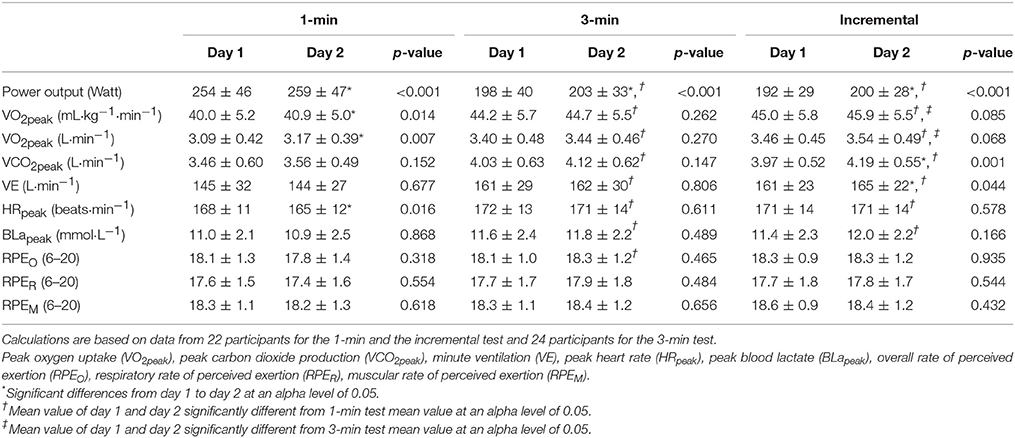Comparison of Peak Oxygen Uptake and Test-Retest Reliability of Physiological Parameters between Closed-End and Incremental Upper-Body Poling Tests
- Department of Neuromedicine and Movement Science, Centre for Elite Sports Research, Norwegian University of Science and Technology, Trondheim, Norway
A corrigendum on
Comparison of Peak Oxygen Uptake and Test-Retest Reliability of Physiological Parameters between Closed-End and Incremental Upper-Body Poling Tests
by Baumgart, J. K., Skovereng, K., and Sandbakk, Ø. (2017). Front. Physiol. 8:857. doi: 10.3389/fphys.2017.00857
In the original article, there was a mistake in Table 1 as published. The mistake concerns the peak power output values provided for the 1-min and the 3-min test. We initially based the calculations on the mean peak power output of the 1-min and the 3-min test on the values provided by the internal software of the Concept2 ski ergometer, which are cumulative averages (i.e., the first average is an average over the first 30 s, the second average is an average over the first minute, the third over one and a half minutes and so forth). However, when submitting this manuscript we recalculated the mean peak power output to reflect 30-s averages that are not cumulative and hence independent of the power output produced in the previous 30-s period.

Table 1. Power output, physiological and perceptual parameters of test day 1 and 2 for a 1-min, a 3-min and an incremental upper-body poling test in able-bodied, upper-body trained participants (means ± SD).
The corrected Table 1 appears below.
In the original article, there was an error. The mistake is in line with what is described in the above.
A correction has been made to the section Results, subsection Comparison of Tests, paragraph 1:
Based on the average values of test day 1 and 2, the incremental (45.4 ± 5.5 mL·kg−1·min−1, 196 ± 28 W) and the 3-min test (44.5 ± 5.5 mL·kg−1·min−1, 201 ± 36 W) resulted in significantly higher VO2peak and lower POpeak as compared to the 1-min test (40.4 ± 5.0 mL·kg−1·min−1, 256 ± 47 W) (all p < 0.001). Additionally, the incremental test resulted in significantly higher VO2peak (p = 0.03).
The authors apologize for these errors and state that this does not change the scientific conclusions of the article in any way.
The original article has been updated.
Conflict of Interest Statement
The authors declare that the research was conducted in the absence of any commercial or financial relationships that could be construed as a potential conflict of interest.
Keywords: peak aerobic capacity, endurance performance, all-out, 3-min, exhaustion
Citation: Baumgart JK, Skovereng K and Sandbakk Ø (2018) Corrigendum: Comparison of Peak Oxygen Uptake and Test-Retest Reliability of Physiological Parameters between Closed-End and Incremental Upper-Body Poling Tests. Front. Physiol. 9:895. doi: 10.3389/fphys.2018.00895
Received: 12 June 2018; Accepted: 21 June 2018;
Published: 03 July 2018.
Edited and reviewed by: Billy Sperlich, Universität Würzburg, Germany
Copyright © 2018 Baumgart, Skovereng and Sandbakk. This is an open-access article distributed under the terms of the Creative Commons Attribution License (CC BY). The use, distribution or reproduction in other forums is permitted, provided the original author(s) and the copyright owner(s) are credited and that the original publication in this journal is cited, in accordance with accepted academic practice. No use, distribution or reproduction is permitted which does not comply with these terms.
*Correspondence: Julia K. Baumgart, amsuYmF1bWdhcnRAZ21haWwuY29t
 Julia K. Baumgart
Julia K. Baumgart Knut Skovereng
Knut Skovereng Øyvind Sandbakk
Øyvind Sandbakk